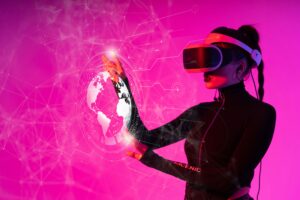Ben Audsley and his team at the Institute of Dentistry are running a project that explores the use of augmented reality in teaching using an app called TINALP.
With the help of TELT, Ben took his proposal to the Ideas Forum, which approved funding for a 1-year pilot of the application. Ben’s team are now working on integrating TINALP into various teaching activities. We interviewed Ben to find out more for our newsletter readers who might be interested in this innovative use of technology.
What is TINALP?
TINALP is an app that can be used on various devices – VR headset, tablet, smartphone. It also has a web interface.
In TINALP you can create or download 3D models for a class. You then control how the learners see the 3D models on their device and decide if you want them to interact with the models. For example, you can ask them to take over the model of a tooth and show you where the pulp chamber is.
You can use different models in one lesson, and you can have more than one model on display at the same time. Some models you can take apart layer by layer, and then move the layers around to show different things. Think of the human body as an example – you can take the skin off, take the bones off, and take the muscles off in an interactive, live teaching session.
Where did the idea of using VR / mixed reality come from?
I feel that a part of my job should be horizon scanning and trying to identify new technology that we can use in the future.
After COVID, we had some money to buy a HoloLens. This was the cutting-edge VR headset at the time. We initially used it for Teams meetings, but then I started thinking about using it in dentistry, such as for live surgeries. We tried live streaming a procedure in the lab but unfortunately the image stabilisation wasn’t good enough.
Wondering what to do with it, I looked at the app store. There’s an app store specifically for the HoloLens, and one of those apps was TINALP. The ability to use phones and tablets to look at the models was a real selling point for me. It would mean that we could teach in a different way.
How do you imagine this would be used in a dental lecture, either in the lab or in the lecture theatre?
Firstly, I would like to use TINALP to assist us with our haptic programme. You can export models from the haptic devices that students have worked on, or that teachers have created as a method of comparison, and then use those 3D images to review what the students are doing right or wrong. We’ve never had the ability to have reflective sessions like that.
We want to enhance the student learning experience and give them different ways of learning. I always use the anatomy example. Traditionally we teach anatomy using PowerPoint in a didactic lecture. It’s not very interactive. But if you had a 3D model of a head and neck that you can pull apart, that’s a new way of learning for our students.
What are you excited about seeing develop?
I think that it has the potential to change the way in which we teach certain topics, not only in dentistry, but across FMD and the wider university. There’s no limit to what 3D models you can upload. If you’re learning geography, you could upload 3D maps of cities. If you’re learning about chemistry and molecules, you can represent them in 3D and have students manipulate them.
What’s next?
I want to hold events for staff to become familiar with the technology and to tell us how they think it could be used in teaching. By the end of the year, we should have produced a number of case studies and enough student feedback to understand the impact and take the project forward.


